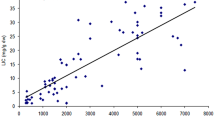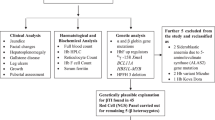Abstract
Beta-thalassemia is the most frequent hereditary blood disorder in Tunisia because of its geographic localization and history. This pathology is characterized by a complex multisystem process with genetic and biochemical interactions. The aim of this work was to establish phenotype/genotype association through studying the distribution and the relationship between β-thalassemia and α-thalassemia mutations and three polymorphic markers: the C → T polymorphism at −158 of the Gγ gene, the RFLP haplotype and the repeated sequence (AT)xTy in the β globin silencer, in two groups of β-thalassemia major and β-thalassemia intermedia (TI) patients. Statistical analysis has shown that moderate expression seen in TI patients was significantly associated to β+ −87 (C → G), −30 (T → A) and IVSI-6 (T → C) mutations, haplotypes VIII, IX and Nb and to XmnI polymorphism. The regression analysis of combined genotypes (mutation/XmnI/RFLP haplotype) revealed that they contribute to justify 17.1 % of clinical expression diversity (p < 0.05). Among the studied genotypes the XmnI polymorphism seems to be the most determinant modulating factor, followed by the β-thalassemia mutation and RFLP haplotype. Our findings highlight the heterogeneity of molecular background of β-thalassemia that would be responsible of clinical variability.

Similar content being viewed by others
References
Fattoum S (2009) Evolution of hemoglobinopathy prevention in Africa: results, problems and prospect. Mediterr J Hematol Infect Dis 1:1
Fattoum S, Abbes S (1985) Some data on the epidemiology of hemoglobinopathies in Tunisia. Hemoglobin 9(4):423–429
Fattoum S (2006) Hemoglobinopathies in Tunisia. An updated review of the epidemiological and molecular data. Tunis Med 84(11):687–696
Camaschella C, Mazza U, Roetto A, Gottardi E, Parziale A, Travi M, Fattore S, Bacchiega D, Fiorelli G, Cappellini MD (1995) Genetic interactions in thalassemia intermedia: analysis of β mutations, γ genotype, γ promoters, and β-LCR hypersensitive sites 2 and 4 in Italian patients. Am J Hematol 48(2):82–87
Ho PJ, Hall GW, Lwo LY, Weatherall DJ, Thein SL (1998) β Thalassemia intermedia: is it possible consistently to predict phenotype from genotype? Br J Hematol 100(1):70–78
Poncz M, Ballantine M, Solowiejczyk D, Barak I, Schwartz E, Surrey S (1983) β-Thalassemia in Kurdish jew. Biol Chem 257:5994
Maggio A, Giambona A, Cai SP, Wall J, Kan YW, Chehab FF (1993) Rapid and simultaneous typing of hemoglobin S, hemoglobin C, and seven Mediterranean beta-thalassemia mutations by covalent reverse dot-blot analysis: application to prenatal diagnosis in Sicily. Blood 81(1):239–242
Old JM, Khan SN, Verma I et al (2001) Multicenter study in order to further define the molecular basis of β-thalassemia in Thailand, Pakistan, Sri Lanka, Mauritius, Syria and India, and to develop a simple molecular diagnostic strategy by amplification refactory mutation system-polymerase chain reaction. Hemoglobin 25(4):397–407
Bibi A, Messaoud T, Beljord C, Fattoum S (2006) Detection of two rare beta–thalassemia alleles found in the Tunisia population: codon 47 (+A) and codons 106/107 (+G). Hemoglobin 30(4):437–447
Fatoum S (2004) Molecular basis of β-thalassemia in the population of Tunisia. Hemoglobin 28(3):177–187
Siala H, Ouali F, Messaoud T, Bibi A, Fattoum S (2008) α-Thalassemia in Tunisia: some epidemiological and molecular data. J Genet 87(3):16
Sutton M, Bouhassira EE, Nagel RL (1989) Polymerase chain reaction applied to the determination of b-like globin gene cluster haplotypes. Am J Hematol 32:66–69
Orkin SH, Kazazian HH Jr, Antonarakis SE, Goff SC, Boehm CD, Sexton JP, Waber PG, Giardina PJ (1982) Linkage of β-thalassemia mutations and β globin gene polymorphisms with DNA polymorphisms in human β globin gene cluster. Nature 296(5858):627–631
Khan SN, Riazuddin S, Galanello R (2000) Identification of three rare β-thalassemia mutations in the Pakistani population. Hemoglobin 24(1):15–22
Trabuchet G, Elion J, Baudot G, Pagnier J, Bouhass R, Nigon VM, Labie D, Krishnamoorthy R (1991) Origin and spread of b-globin gene mutations in India, Africa, and Mediterranea: analysis of the 50 flanking and intragenic sequences of βS and βc genes. Hum Biol 63(3):241–252
Salome N (1985) Haplotypes chromosomiques et mutations β-thalassémiques dans la population algérienne. Thèse de Doctorat, Sciences, Université Claude Bernard, LyonI
Chibani J, Vidaud M, Duquesnoy P, Berge-Lefranc JL, Pirastu M, Ellouze F et al (1988) The peculiar spectrum of β-thalassemia genes in Tunisia. Hum Genet 78:190
Chouk I, Daoud BB, Mellouli F, Bejaoui M, Gérard N, Dellagi K, Abbes S (1993) Contribution to the description of the beta-thalassemia spectrum in Tunisia and the origin of mutation diversity. Hemoglobin 3:189–195
Haj Khelil A et al (2010) Hemoglobinopathies in North Africa: a review. Hemoglobin 34:1–23
Jouini L, Bibi A, Ouali F, Hadj Fredj S, Ouennich F, Siala H, Messaoud T, Fattoum S (2011) Contribution of β-globin cluster polymorphisms to raise fetal hemoglobin levels in normal adults. Mol Biol Rep 39(4):4619–4625
Haj Khelil A et al (2011) Xmn I polymorphism associated with concomitant activation of Gγ and Aγ globin gene transcription on a β0-thalassemia chromosome. Blood Cells Mol Dis 46:133–138
Ferrara M, Matarese S, Francese M, Borrelli B, Perrotta Meo A, La rosa M, Esposito L (2003) Role of polymorphic sequence 5′ to the Gγ gene and 5′ to the β gene on the homozygous β-thalassemia phenotype. Hemoglobin 27(3):167–175
Merghoub T, Perichon B, Maier-Redelsperger M, Dibenedetto SP, Samperi P, Ducrocq R, Feingold N, Elion J, Schiliro G, Labie D, Krishnamoorthy R (1997) Dissection of the association status of two polymorphisms in the β globin gene cluster with variations in F-cell number in non-anemic individuals. Am Hematol 56(4):239–243
Labie D, Srinivas R, Dunda O, Dode C, Lapoumeroulie C, Devi V, Devi S, Ramasami K, Elion J, Ducrocq R, Krishnamoorthy R, Nagel RL (1989) Haplotypes in tribal Indians bearing the sickle gene: evidence for the unicentric origin of the βS mutation and the unicentric origin of the tribal populations of India. Hum Biol 61:479–491
Labie D, Dunda-Belkhodja O, Rouabhi F, Pagnier J, Ragusa A, Nagel RL (1985) The −158 site 5′ to the Gγ gene and Gγ expression. Blood 66(6):1463–1465
Flint J, Harding RM, Clegg JB, Boyce AJ (1993) Why are some genetic diseases common? Distinguishing selection from other processes by molecular analysis of globin gene variants. Hum Genet 9:91–117
Perrin P, Bouhassa R, Mselli L, Garguier N, Nigon VM, Bennani C, Labie D, Trabuchet G (1998) Diversity of sequence haplotype associated with β-thalassemia mutations in Algeria: implication for their origin. Gene 213:169–177
Chakravarti A, Buetow KH, Antonarakis SE, Waber PG, Boehm CD, Kazazian HH (1984) Nonuniform recombination within the human β-globin gene cluster. Am J Hum Genet 36:1239–1258
Antonarakis SE, Boehm CD, Giardina Pj, Kazazian HH Jr (1982) Nonrandom association of polymorphic restriction sites in the β globin gene cluster. Proc Natl Acad Sci USA 79(1):137–141
Haj Khelil A, Laradi S, Miled A, Tadmouric GO, Ben Chibania J, Perrin P (2004) Clinical and molecular aspects of haemoglobinopathies in Tunisia. Clin Chim Acta 340:127–137
Taher A, Isma’eel H, Cappellini MD (2006) Thalassemia intermedia: revisited. Blood Cells Mol Dis 37:12–20
Thein SL (2004) Genetic insights into the clinical diversity of beta thalassemia. Br J Haematol 124:264–274
Uda M, Galanello R, Sanna S et al (2008) Genome-wide association study shows BCL11A associated with persistent fetal hemoglobin and amelioration of the phenotype of beta-thalassemia. Proc Natl Acad Sci USA 105(5):1620–1625
Lettre G, Sankaran VG, Bezerra MAC et al (2008) DNA polymorphisms at the BCL11A, HBS1L-MYB, and β-globin loci associate with fetal hemoglobin levels and pain crises in sickle cell disease. Proc Natl Acad Sci USA 105(33):11869–11874
Mejri A, Siala H, Ouali F, Bibi A, Messaoud T (2012) Identification of candidate genes involved in clinical variability among Tunisian patients with β-thalassemia. Gene 506:166–172
Acknowledgments
This work has been supported by the Ministry of scientific research and technology and competence development (LR2000 Lab Sante′-01).
Author information
Authors and Affiliations
Corresponding author
Rights and permissions
About this article
Cite this article
Jouini, L., Sahli, C.A., Laaouini, N. et al. Association between clinical expression and molecular heterogeneity in β-thalassemia Tunisian patients. Mol Biol Rep 40, 6205–6212 (2013). https://doi.org/10.1007/s11033-013-2732-y
Received:
Accepted:
Published:
Issue Date:
DOI: https://doi.org/10.1007/s11033-013-2732-y




